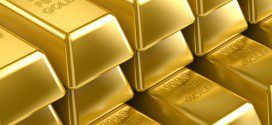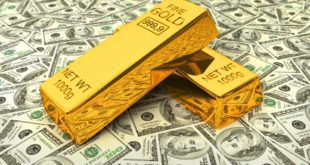Before this great financial crisis ever comes to a close, you’ll see the Federal Reserve copy Europe and also  implement negative deposit rates to try and get commercial banks to lend money into the economy. I have absolutely no doubt about it – and it will have three chief consequences for the markets. Let me explain.
implement negative deposit rates to try and get commercial banks to lend money into the economy. I have absolutely no doubt about it – and it will have three chief consequences for the markets. Let me explain.
The above are edited excerpts from an article* by Larry Edelson (swingtradingdaily.com) entitled Mining shares: Negative Rates Set Stage for Massive Bull Market.
The following article is presented by Lorimer Wilson, editor of www.munKNEE.com (Your Key to Making Money!), www.FinancialArticleSummariesToday.com (A site for sore eyes and inquisitive minds) and the FREE Market Intelligence Report newsletter (register here; sample here) and has been edited, abridged and/or reformatted (some sub-titles and bold/italics emphases) for the sake of clarity and brevity to ensure a fast and easy read. This paragraph must be included in any article re-posting to avoid copyright infringement.
Edelson goes on to say in further edited excerpts:
The real disaster facing the world is not the U.S. – it’s Europe – because:
- its economy is dying. It is collapsing in the nightmarish consequences of horrendous policy decisions, the most ill-advised of which was the implementation of the euro, not to mention the euro region’s mountain of debts that are going bad.
- its in a depression – a deflationary depression that will only get worse.
- 123 million people — one out of every six – now live in poverty
- total unemployment is above 20% in many countries
- youth unemployment is greater than 60%.
The above is precisely why the European Central Bank (ECB), headed by Mario Draghi…is now charging any European bank that wishes to deposit funds with the ECB a negative interest rate, or penalty, of MINUS 0.10% but, mark my words, Draghi’s negative deposit rate won’t matter one iota when it comes to Europe’s depression.
Europe’s depression will only end when the euro breaks apart at the seams and each country is allowed to take back its native currency, devalue it and stoke the flames of inflation. Until then, Europe will continue to sink deeper and deeper into depression and, the longer Europe’s policymakers try to stick to the hair-brained single currency, the worse the social chaos in Europe will become, as the war cycles I have been telling you about ramp up ever higher.
Stay connected
- Subscribe to our Newsletter (register here; sample here)
- Find us on Facebook
- Follow us on Twitter (#munknee)
- Subscribe via RSS
What negative central bank rates mean for the markets is the heart of the matter for us investors.
I see 3 chief consequences:
- Since negative rates have hit Europe first, we should now see the euro’s demise accelerate as there is nothing to prevent European banks from taking their excess funds and depositing them into banks in other countries where they can indeed get a better return, instead of being penalized and that’s going to depress the euro, and cause other stronger currencies to rally: Asian currencies, and especially the U.S. dollar — which is now clearly in bull mode.
- On a longer-term basis, we will see...the Dow Industrials eventually heading toward the 32,000 level…
- We are going to see a renewed bull market in commodities, especially gold, silver and select mining shares.
There are 2 simple reasons [for point #3 above]:
- Europe’s economy is in worse shape than most people realize … and the euro is on its death bed – and that means savvy European money is now going to take a fresh look at tangible assets — commodities — again, especially gold and silver.
- It’s a huge boon to mining shares, just like it was in the 1930s, when Europe last went bankrupt.
- [At that time] mining shares such as Homestake Mining soared from $65 a share in 1929 to nearly $373 in 1933 — a 474% gain in just four years and where
- Dome Mining soared from $6 to $39.50, a 558% gain.
- Thing is, this time around, the gains in mining shares will likely be far greater, even greater than they were in the first phase of gold’s bull market from 2000 to 2011.
The two 2 reasons [for the above are that]:
1. Due to gold’s three-year bear market, many mining shares…[have been] completely destroyed and, as a result, there are now only a handful of mining shares that savvy investors would want to buy. That means a rush to buy the best of the best, which will rocket their share prices higher, multiplying investors’ money many times over.
2. As the war cycles continue to ramp higher and the world enters an almost unprecedented period of social chaos, the flood of money into commodities and mining shares will become ever greater.
Editor’s Note: The author’s views and conclusions in the above article are unaltered and no personal comments have been included to maintain the integrity of the original post. Furthermore, the views, conclusions and any recommendations offered in this article are not to be construed as an endorsement of such by the editor.
*www.swingtradingdaily.com/2014/06/09/mining-shares-negative-rates-set-stage-for-massive-bull-market/ (Copyright 2014 SwingTradingDaily.com All Rights Reserved ; P.S. To help you position yourself to ride this tsunami of rising stock prices, I have a special gift for you: My FREE Dow 31,000 Preparedness Kit. Click here to get your copy now!
Related Articles:
1. Fed Funds Cycle Suggests Positive Outlook for Gold – Here’s Why
Below is some interesting research by Doug Peta of BCA Research regarding the Fed Funds Rate Cycle, and what that research – as well as our own in-house research – could mean for gold to help you understand the positivity we see for the precious metal looking towards 2015. Read More »
2. Deflationary Depression Delayed BUT Will Be That Much Worse When It Inevitably Comes
When there is lots of economic activity, there is lots of money changing hands. When there is not very much economic activity, the pace at which money circulates through our system slows down. That is why what is happening in the U.S. right now is so troubling. Let me explain. Read More »
3. Blame Deflationary Pressures On Current Prices Of Gold & Silver
I believe that the inflation and price charts paint a clear picture, and that until inflation in the world picks up significantly, there will be no meaningful rallies in precious metals…[While] I am bullish on gold and silver long term, the short-term pressure is still evident and might take them lower in the next couple of months. Read More »
4. Tips from TIPS on Prospects for Growth, Outlook for Inflation & Future for Gold
TIPS are telling us that the market is quite pessimistic about the prospects for real growth, but not concerned at all about the outlook for inflation. Read More »
5. Probability of Deflation Is 60%, Inflation Is 25% and Muddling Through Is 15% – Here’s Why
At the end of last year virtually every every single economist expected interest rates to rise this year as the Fed tapered their purchases and the economy improved but, in fact, interest rates on the 10 year U.S. Treasury have been going down year to date (from 3% to 2.5% after rising from about 1.6% to 3% last year). The masses, going along with this crowd, got fooled but we have been calling for a decline in interest rates for some time now due to world-wide deflation and it couldn’t be clearer to us that this is the most likely scenario for the United States. Let us explain. Read More »
 munKNEE.com Your Key to Making Money
munKNEE.com Your Key to Making Money



Call it whatever you want, when the value of the paper/flat currency you have you decreases in value, your PM’s will climb upward…
Ask yourself, “What percentage of your portfolio should be in PM’s?”
Got PM’s?